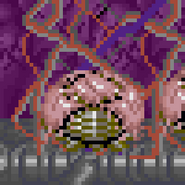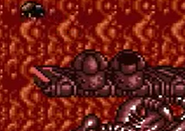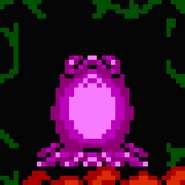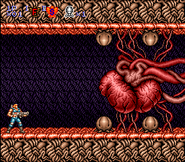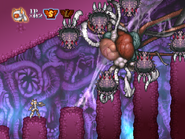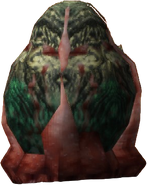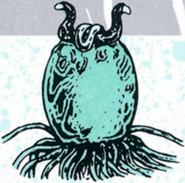| “ | A biological plant-like biofortress that keeps producing Backers indefinitely. | „ |
| ~ Translated official description from Neo Contra |
The Eggron (妖卵工 グロン Youran Eguron?, lit. "Wicked Ovum Eggron") is a recurring enemy in the Contra series. It is a living alien egg that constantly produces Buggers.
Description
Pulsating giant alien eggs scattered along caverns deep beneath the earth, on the path that leads to the hive. These living vessels remain stationary and hatch after a brief period of time by opening its segmented body from the top –in a similar manner as flower petals– and letting loose a newborn Bugger that quickly scurries along the floor. In most games, the eggs are not limited to give birth to just one creature and they will keep on producing more until destroyed.
Eggrons are renowned for appearing in battles against Gomeramos King, constantly producing Buggers as the giant alien heart's only form of attack and defense.
Appearances
Super Contra
The Eggrons in the original arcade version of Super Contra are unique in a few behavioral and aesthetic aspects that differentiate them from most of their incarnations in other games from the series.
Eggrons are found in Area 4, Alien 1, but unlike the rest of these enemies' appearances in other titles, they release Bundles instead of the usual Buggers.
- Main article: Peeking Alien Egg
A unique variant of Eggron is found earlier in Area 3, Deep Jungle, although it is much larger than the common variant and the embryo inside it attacks by peeking and spewing Poisonous Insect Gels from it.
The NES conversion of the game, Super C, features more levels and enemies than its arcade counterpart. One of these levels is Alien Area 2, where the player has to make their way down an alien environmental construct. About two thirds into the level, the player will reach a series of relatively small platforms, with almost all of them having a pair of Eggrons. Unlike the arcade game, these Eggrons behave like those in the rest of the games, by periodically releasing quickly scurrying Buggers. If the player is carrying the adequate armament and aims properly, they may be able to destroy a few of these cocoons from the platforms above.
Contra: Hard Corps
In Probotector, the European Mega Drive version of Contra: Hard Corps, downed Zako Soldiers are changed into alien eggs resembling Eggrons. These eggs release Zako Aliens.
Contra: Shattered Soldier
Four Eggrons appear during the battle against Gomeramos King. Each egg is worth 2% Hit Rate and all four must be eliminated before the alien heart to achieve a high Player Ranking (totaling 8% Hit Rate from all four Eggrons combined). These Eggrons appear blue but otherwise are identical to previous counterparts.
Contra ReBirth
Unlike most games, where they're usually found in the final levels, in Contra ReBirth, Eggrons can be found in the very first stage, Satellite Warzone, and their behavior is a little different. Instead of just lying on either the ground or ceiling, they are more mobile this time around and actively dig through hard metal to break inside the base; once inside, they hatch and release a single cycloptic and tentacled brain-like creature (which makes the part of a Bugger) which then scurries along the floor.
Once it has opened, the Eggron will die. However, more Eggrons will keep on breaking in on the same area from where the first one appeared and won't stop until about seven of them have gotten inside. The player can either just deal with the first brain creature(s) and move onward while evading the rest, or play it safe and camp for a moment while shooting all the Eggrons until no more come out. However, many Eggron spawning spots are generally found one after another, either on the ground or ceiling, so progression through the level will become very slow in the latter case.
Eggrons reappear in the last level, Red Falcon Megalith, in the fight against Gomeramos King, reenacting their role from previous games by constantly releasing the brain-like creatures to defend the boss, with the main difference being that the geography of the terrain is quite unique this time around, being comprised of thin columns placed along an inclined layout.
Contra: Rogue Corps
Sometimes referred to as Egg spawners by Lily. These large eggs spawn up to five Balloon-like Fiends per egg. They spawn at an extremely fast rate. Some mission objectives require the Rogue Corps to eliminate these eggs before advancing any further.
The Crab-type Fiend can, over time, enter an egg-like state where if left in its eggshell, will eventually break out and grow in size. The Fiend can achieve an egg-state three times per one encounter.
Contra: Operation Galuga
In addition to standard Eggrons (which appear similar to previous incarnations), there is also large yellow eggs that can hold people hostage from within. Two of these eggs are encountered in the Alien Hive: the first one is automatically spotted by Bill Rizer, where he blasts it revealing a captive Stanley Ironside, who once freed staggers to get up and then blasts out of the hive. A second egg is encountered immediately before Kimkoh's lair. Hanging from the ceiling, blasting it reveals a captured Bradley, who is surprised to hear about alien invaders at work, then flees out of the Hive for his life. After Java's defeat, he is seen at the end of the game successfully escaping the lair, though within moments, he falls to his knees and transforms into a fur-covered beast.
Gallery
Screenshots
Sprites and models
Artworks
Trivia
- The shape and manner Eggrons behave, as well as the type of enemies they give birth to, are direct references to the ovomorphs and facehuggers from the Alien franchise, which the Contra takes inspiration from.
- Mohd H, an enemy from Gradius II: GOFER no Yabō (also by Konami), looks and behaves almost identically to an Eggron. In fact, the sprite of the Eggron in the NES version of Super C is identical to the sprite of the Mohd H in the NES version of Gradius II.
See also
References
- ↑ Internal name from Contra: Operation Galuga.
- ↑ Contra: Rogue Corps
